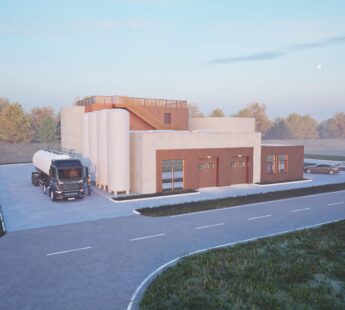News
Buildings
Combined heat and power production
District energy
+13
Aalborg CSP receives order for lid solution for Integrated Pit Thermal Energy Storage (PTES) System


The two Danish utility companies, Høje Taastrup Fjernvarme and VEKS are currently establishing a 70,000 m3 PTES Integrated Energy Solution in Høje Taastrup near Copenhagen, Denmark – a project which will include the world’s most advanced PTES lid technology developed and patented for large-scale commercialization. The parties have recently signed a contract with the Danish renewable and energy storage specialist, Aalborg CSP, for design and delivery of a 11,000 m2 insulating lid. The purpose of the PTES lid is to minimize the heat loss inside the PTES. The lid solution from Aalborg CSP is based on the development of a durable technology, which ensures stable operation over the lifetime of the project.
The PTES in Høje Taastrup is a thermal storage functioning as a thermal battery with a capacity of 3,300 MWh. The thermal battery is charged by heat from the transmission grid and discharged to the district heating network when the demand for heating increases. The heat is stored, when the price on heating is low and is utilized later on, when the price for heating increases. The PTES project in Høje Taastrup is a great example of flexible and efficient sector coupling within the power and district heating sectors. Sector coupling is one of the main elements within the sustainable energy system of the future and is thus a key element in reaching the global environmental, energy and climate targets of 2050.
“It is the first time this type of storage is used in one of the very large district heating networks in Denmark. The project is a development project. To further optimize the durability and lifetime expectancy of the storage, we have worked with different types of technical solutions, when it comes to, among other things, material selection. We chose the new PTES lid solution from Aalborg CSP, as we believe that it is a reliable solution, which will help ensure a low heat loss.” – says Astrid Birnbaum, CEO, Høje Taastrup Fjernvarme A.m.b.a.
“We look forward to witnessing the Danish-produced lid solution meeting our requirements for the highest possible energy efficiency. This is a "state of the art" solution, which the entire district heating supply and thus all district heating customers within the metropolitan area of Copenhagen will benefit from," - notes Finn Bruus, Team Leader, Projects at VEKS.
The aim of the PTES Integrated Energy System project in Høje Taastrup is to make the district heating supply more efficient and minimize the expensive peak load production. Besides reducing the peak loads that occur throughout the day within a district heating network, the storage will also add flexibility to the heat production for optimal utilization of the district heating.
With the unique solution from Aalborg CSP, Høje Taastrup and VEKS will benefit from a PTES solution with a lid that prevents accumulation of air, water and moisture inside the insulation in an efficient way. The PTES lid helps increase the efficiency and reliability of the storage and ensures long-term durability of the storage.
“The technology for efficient and cheap energy storage is already here – and it is Danish and matches our energy system and that of entire Northern Europe. For decades, pioneers in Denmark have worked with the PTES technology and have helped ensure that today we have a well-proven foundation for long-term and bankable investments in energy storage, which is an important element in a successful green energy transition”. says Svante Bundgaard, CEO at Aalborg CSP A/S.
Unique lid solution reduces heat loss and boosts the efficiency to commercialize PTES
The PTES lid solution, which will be installed in Høje Taastrup is based on a new and patented design developed with primary focus on making a bankable investment and removing risks in the design, operation and maintenance conditions, which a PTES will be exposed to throughout the lifetime of the system.
The purpose of the new design is to address and solve the problems and challenges as well as minimizing the risks, which are typically experienced during the installation and operation of a PTES. This design improves the quality and reliability of PTES systems, contributes to lower heating bills for the consumers and adds flexibility to the energy system.
The PTES lid solution from Aalborg CSP differs from traditional PTES lids in a number of ways, which controls internal vapor, external rainfall, automatic ventilation and lid insulation. This ensure a reliable technology, a long lifetime and reduces the heat loss inside the storage.
These unique design features minimize the heat loss inside the PTES and is contributing to increased efficiency and reliability of the complete energy system. This is a key step in commercializing the PTES technology, where it is expected to see millions of m3 capacity of PTES Integrated Energy Solutions installed in Denmark as well as other European countries
A full-scale version of the new PTES lid design has been tested at Marstal Fjernvarme, where it has been included in the Integrated Energy System already counting Solar and Biomass. In Marstal, the new lid replaced the original PTES lid, which was of a previous design and damaged due to moisture accumulation inside the PTES lid construction. This recent replacement has resulted in a full-automatic operation with a minimum of maintenance and supervision. Likewise, the heat loss inside the PTES has been reduced, thereby increasing the efficiency.
Project facts:
Owner: Høje Taastrup Fjernvarme A.m.b.a. and VEKS
Capacity of PTES energy storage: 3,300 MWh
Volume of PTES energy storage: 70,000 m3
Area – PTES lid: 11,000 m2
No. of consumers: 500,000
Location: Høje Taastrup, Zealand, Denmark
Expected lifetime of lid: 30 years
CO2 savings: 15,000 tons CO2 per year
You should consider reading
Perspective
Sector coupling
+9
New white paper: Unlocking the potential of renewable energy through sector coupling
23 October 2024solutions
Combined heat and power production
+6
CopenHill: The story of the iconic waste-to-energy plant
20 November 2024solutions
Energy efficiency in buildings
+2















